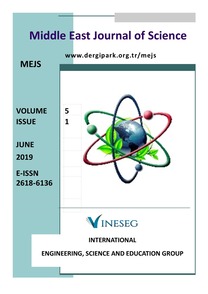BIOSENSOR PROPERTIES OF PLASMONIC SILVER NANOPARTICLES PRODUCED BY THE PLD MECHANISM
___
[1] C.-T. Liu, and A.-N. Tang, “Applications of nanoparticles in elemental speciation,” Analytical Letters, 48(7), 1031-1043, 2015.[2] N. Li, D. Liu, and H. Cui, “Metal-nanoparticle-involved chemiluminescence and its applications in bioassays,” Analytical and bioanalytical chemistry, 406(23), 5561-5571, 2014.
[3] C. L. Haynes, and R. P. Van Duyne, "Nanosphere lithography: a versatile nanofabrication tool for studies of size-dependent nanoparticle optics," ACS Publications, 2001.
[4] A. R. Tao, S. Habas, and P. Yang, “Shape control of colloidal metal nanocrystals,” small, 4(3), 310-325, 2008.
[5] E. Ringe, B. Sharma, A.-I. Henry et al., “Single nanoparticle plasmonics,” Physical Chemistry Chemical Physics, 15(12), 4110-4129, 2013.
[6] A. Powell, M. Wincott, A. Watt et al., “Controlling the optical scattering of plasmonic nanoparticles using a thin dielectric layer,” Journal of Applied Physics, 113(18), 184311, 2013.
[7] A. L. González, C. Noguez, and A. S. Barnard, “Mapping the structural and optical properties of anisotropic gold nanoparticles,” Journal of Materials Chemistry C, 1(18), 3150-3157, 2013.
[8] T. Ahmad, I. A. Wani, J. Ahmed et al., “Effect of gold ion concentration on size and properties of gold nanoparticles in TritonX-100 based inverse microemulsions,” Applied Nanoscience, 4(4), 491-498, 2014.
[9] W. A. Murray, B. Auguié, and W. L. Barnes, “Sensitivity of localized surface plasmon resonances to bulk and local changes in the optical environment,” The Journal of Physical Chemistry C, 113(13), 5120-5125, 2009.
[10] M. M. Miller, and A. A. Lazarides, “Sensitivity of metal nanoparticle surface plasmon resonance to the dielectric environment,” The Journal of Physical Chemistry B, 109(46), 21556-21565, 2005.
[11] A. C. Templeton, W. P. Wuelfing, and R. W. Murray, “Monolayer-protected cluster molecules,” Accounts of chemical research, 33(1), 27-36, 2000.
[12] M. A. El-Sayed, “Some interesting properties of metals confined in time and nanometer space of different shapes,” Accounts of chemical research, 34(4), 257-264, 2001.
[13] L. N. Lewis, “Chemical catalysis by colloids and clusters,” Chemical Reviews, 93(8), 2693-2730, 1993.
[14] T. Tani, Silver nanoparticles: from silver halide photography to plasmonics: Oxford University Press, USA, 2015.
[15] S. R. Nicewarner-Pena, R. G. Freeman, B. D. Reiss et al., “Submicrometer metallic barcodes,” Science, 294(5540), 137-141, 2001.
[16] S. A. Maier, M. L. Brongersma, P. G. Kik et al., “Plasmonics—a route to nanoscale optical devices,” Advanced materials, 13(19), 1501-1505, 2001.
[17] P. V. Kamat, "Photophysical, photochemical and photocatalytic aspects of metal nanoparticles," ACS Publications, 2002.
[18] C. Murray, S. Sun, H. Doyle et al., “Monodisperse 3d transition-metal (Co, Ni, Fe) nanoparticles and their assembly intonanoparticle superlattices,” Mrs Bulletin, 26(12), 985-991, 2001.
[19] S. Nie, and S. R. Emory, “Probing single molecules and single nanoparticles by surface-enhanced Raman scattering,” science, 275(5303), 1102-1106, 1997.
[20] L. A. Dick, A. D. McFarland, C. L. Haynes et al., “Metal film over nanosphere (MFON) electrodes for surface-enhanced Raman spectroscopy (SERS): Improvements in surface nanostructure stability and suppression of irreversible loss,” The Journal of Physical Chemistry B, 106(4), 853-860, 2002.
[21] K. M. Mayer, and J. H. Hafner, “Localized surface plasmon resonance sensors,” Chemical reviews, 111(6), 3828-3857, 2011.
[22] C. W. Hsu, B. G. DeLacy, S. G. Johnson et al., “Theoretical criteria for scattering dark states in nanostructured particles,” Nano letters, 14(5), 2783-2788, 2014.
[23] T. R. Jensen, M. L. Duval, K. L. Kelly et al., “Nanosphere lithography: effect of the external dielectric medium on the surface plasmon resonance spectrum of a periodic array of silver nanoparticles,” The Journal of Physical Chemistry B, 103(45), 9846-9853, 1999.
[24] K. Hamamoto, R. Micheletto, M. Oyama et al., “An original planar multireflection system for sensing using the local surface plasmon resonance of gold nanospheres,” Journal of Optics A: Pure and Applied Optics, 8(3), 268, 2006.
[25] G. Mie, “Articles on the optical characteristics of turbid tubes, especially colloidal metal solutions,” Ann. Phys, 25(3), 377-445, 1908.
[26] I. Abdulhalim, M. Zourob, and A. Lakhtakia, “Surface plasmon resonance for biosensing: a minireview,” Electromagnetics, 28(3), 214-242, 2008.
[27] D. R. Shankaran, K. V. Gobi, and N. Miura, “Recent advancements in surface plasmon resonance immunosensors for detection of small molecules of biomedical, food and environmental interest,” Sensors and Actuators B: Chemical, 121(1), 158-177, 2007.
[28] F. S. R. R. Teles, “Biosensors and rapid diagnostic tests on the frontier between analytical and clinical chemistry for biomolecular diagnosis of dengue disease: A review,” Analytica chimica acta, 687(1), 28-42, 2011.
[29] P. Leonard, S. Hearty, J. Brennan et al., “Advances in biosensors for detection of pathogens in food and water,” Enzyme and Microbial Technology, 32(1), 3-13, 2003.
[30] A. Olaru, C. Bala, N. Jaffrezic-Renault et al., “Surface plasmon resonance (SPR) biosensors in pharmaceutical analysis,” Critical reviews in analytical chemistry, 45(2), 97-105, 2015.
[31] R. G. Smith, N. D'Souza, and S. Nicklin, “A review of biosensors and biologically-inspired systems for explosives detection,” Analyst, 133(5), 571-584, 2008.
[32] W. Haiss, N. T. Thanh, J. Aveyard et al., “Determination of size and concentration of gold nanoparticles from UV− Vis spectra,” Analytical chemistry, 79(11), 4215-4221, 2007.
- ISSN: 2618-6136
- Yayın Aralığı: 2
- Başlangıç: 2015
- Yayıncı: -
IN-VITRO INVESTIGATION OF DONKEY MILK EFFICACY AGAINST STANDARD STAPHYLOCOCCUS AUREUS STRAINS
Mehmet DEMİRCİ, Serap KILIÇ ALTUN, Bekir Sami KOCAZEYBEK, Akın YİĞİN
INVESTIGATION OF PLACENTAL HOFBAUER CELLS BY IMMUNOHISTCHEMSTRY METHODS IN COMPLICATED PREGNANCIES
Yusuf NERGİZ, Şebnem NERGİZ ÖZTÜRK, Fırat AŞIR, Ayşe ŞAHİN, Elif AĞAÇAYAK
BIOSENSOR PROPERTIES OF PLASMONIC SILVER NANOPARTICLES PRODUCED BY PLD
İlhan CANDAN, Serap YİĞİT GEZGİN, Yasemin GÜNDOĞDU, Hadice BUDAK GÜMGÜM
BIOSENSOR PROPERTIES OF PLASMONIC SILVER NANOPARTICLES PRODUCED BY THE PLD MECHANISM
İlhan CANDAN, Serap YİĞİT GEZGİN, YASEMİN GÜNDOĞDU, Hadice BUDAK GUMGUM
ESTIMATION OF NEUTRONS OCCURRING IN THE LINAC ROOM AT DIFFERENTPHOTON ENERGIES
THREE MSA TOOLS ANALYSIS IN DNA AND PROTEIN DATASETS
Fırat AŞIR, Tuğcan KORAK, Özgür ÖZTÜRK
Fırat AŞIR, Tuğcan KORAK, Özgür ÖZTÜRK
Akın YİĞİN, Mehmet Demirci, SERAP KILIÇ ALTUN, Bekir KOCAZEYBEK
INVESTIGATION OF PLACENTAL HOFBAUER CELLS BY IMMUNOHISTOCHEMISTRY METHODS IN COMPLICATED PREGNANCIES
Yusuf NERGİZ, Şebnem NERGİZ, Fırat AŞIR, Ayşe ŞAHİN, Elif AGACAYAK
